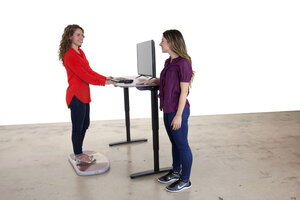The rise of standing desks: More than Silicon Valley status symbols?
Traditionalists say the chair is here to stay, but more offices and even classrooms are turning to standing desks. Why?

Standing desks are becoming more popular as studies show a rise in productivity. Shown here, a Wurf, standing pad that encourages micro-movements during the day.
Wurf.com
Standing desks in the office have typically been associated with innovative tech companies such as Facebook, Twitter, and Google. But the less-sedentary workstation is migrating beyond Silicon Valley – to classrooms and other industries – as studies show improved productivity, more creativity, and higher test scores.
“Go into cubeland in a tightly controlled corporate environment and you immediately sense that there is a malaise about being tied behind a computer screen seated all day,” Dr. James Levine, a researcher at the Mayo Clinic in Minnesota, told The New York Times. “The soul of the nation is sapped, and now it’s time for the soul of the nation to rise.”
Proponents of standing desks often cite the health benefits. But some research indicates other benefits, including improved creativity and productivity. Informal tests, including one by Latvia's social media company Draugiem Group, found a 10-percent increase in productivity. Julia Gifford of the Draugiem group wrote:
While standing, you feel a sense of urgency which causes you to be focused on the completion of tasks. This works ideally when you're working with tasks where you know what the outcome should be, and it's just a matter of completing it.
But Ms. Gifford says her firm didn't find standing conducive to creativity.
However, for tasks which require a creative approach – for example, thinking about a possible coding solution, or writing a great article – then the urgency provided by standing is more of a hindrance. We found that for creative tasks, sitting and not paying attention to your corporal self was helpful in letting your mind wander and explore creative options.
That conflicts with the findings of a 2014 article published by Stanford University researchers Marily Oppezzo and Daniel Schwartz, which suggest that walking had a significant effect on creativity. In their experiment, the researchers found that “the average increase in creative output was around 60%” for participants walking compared to participants sitting.
And while most jobs are not conducive to long walks and require an office setting, experts say standing desks offer an appealing alternative.
“Movement is thought liberated,” Mark Publicover, inventor of the Wurf board of Santa Cruz, Calif., tells The Christian Science Monitor. The Wurf board is a lightweight, air-filled floor pad designed to help users stand comfortably at a workstation. By encouraging continuous micro movements, the Wurf board claims to relax the mind and strengthen the body.
“When you’re able to liberate your thought, you tend to move. When you say ‘Hey that’s a great idea!’ You automatically rise to attention because something has awakened you mentally and it reflects physically,” says Mr. Publicover.
Similarly, Assistant Prof. Andrew Knight of the Olin Business School at Washington University found that stand-up meetings encouraged greater collaboration and creativity between employees. “Our study shows that even a small tweak to a physical space can alter how people work with one another,” Mr. Knight tells The Telegraph.
Schools are starting to adopt the standing desk too.
The Vallecito Elementary School in San Rafael, Calif., claims to be the first to use standing desks in every classroom. And it's not cheap, up to $6,000 per classroom.
Vallecito principal Tracy Smith told CBS News that the students were initially tired from standing all day. But Smith said within a few months, they were more focused, confident, and productive. Teachers also took some time to grow adjusted to all the movement in the classroom, but Smith said she believes her staff understands the purpose and is "100 percent behind it."
“It’s completely unnatural to ask a child to sit all day and not move. Moving helps students be engaged in an idea, and be motivated and inspired by that idea,” says Publicover. To help promote an active atmosphere in schools, Wurf board plans donate to schools one board for every ten sold. “It’s only natural that standing helps students be more effective learners.”
In an experiment with students in Rochester, Minn., Dr. Levine and his team installed mobile stations around the classroom for the children to move with their laptops. And after two months, the results signaled a clear difference. By standing and moving throughout the school day, children doubled their activity level compared to when they were in a traditional classroom and they scored up to 20 percent higher on state standardized tests.
“Their scores are better, their attention is better, their specific skill development is better,” Levine told NBC News. “If that is the case, it is therefore self-evident that this has to be the future.”

